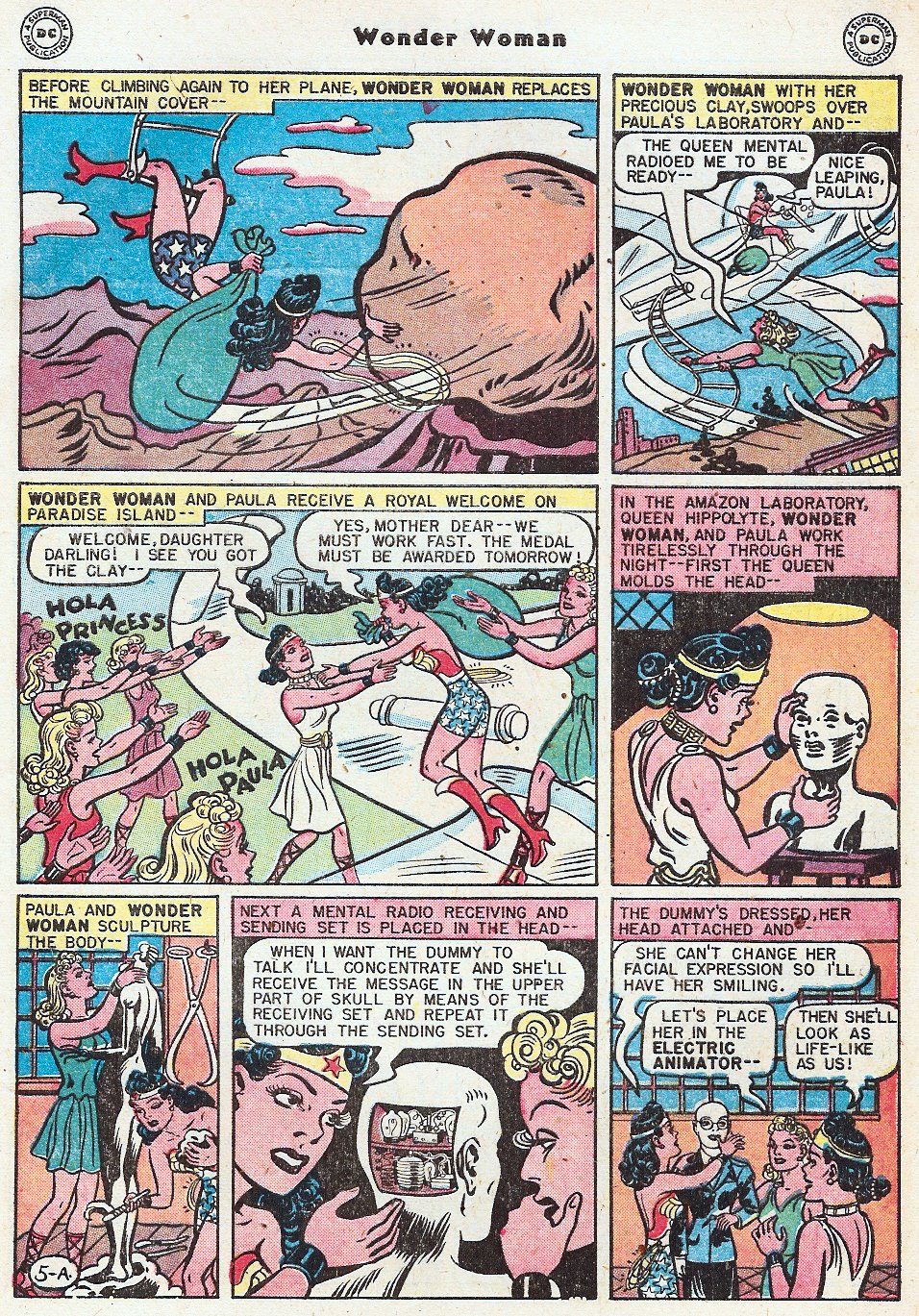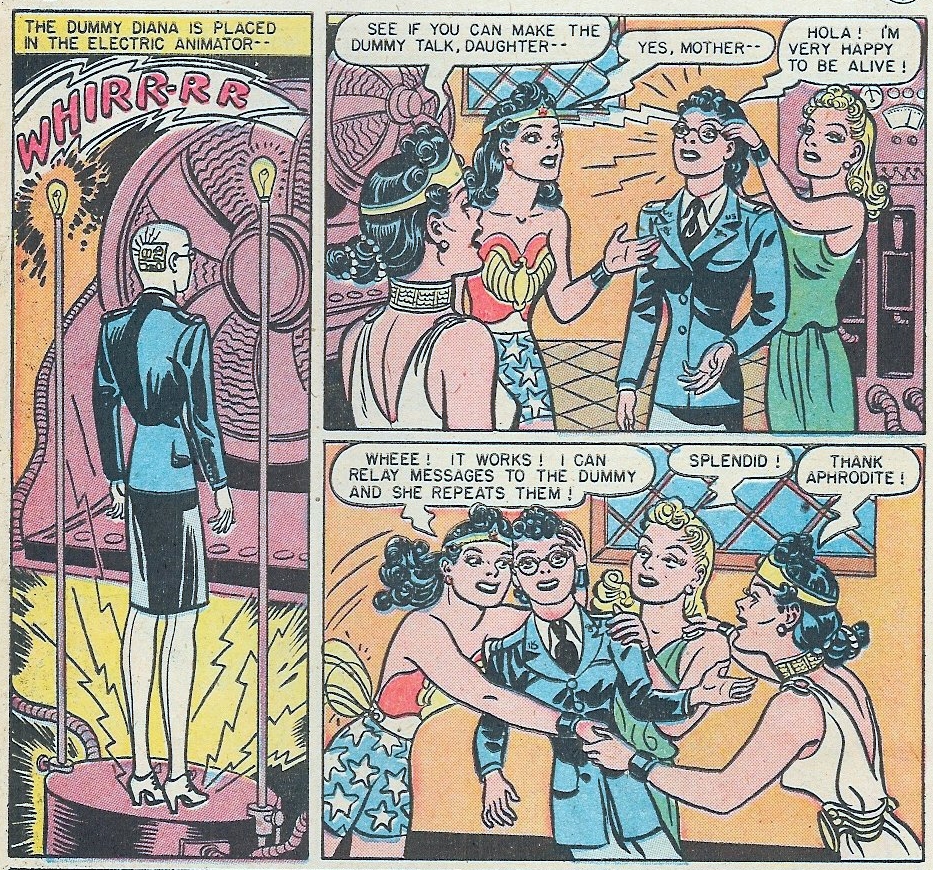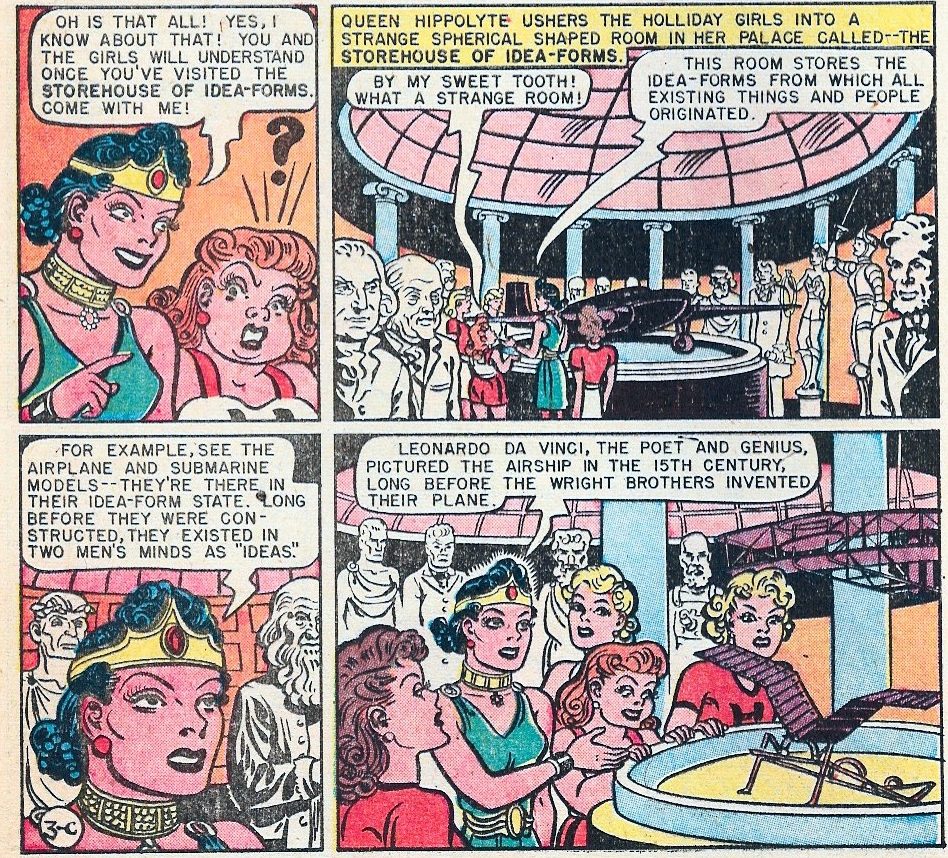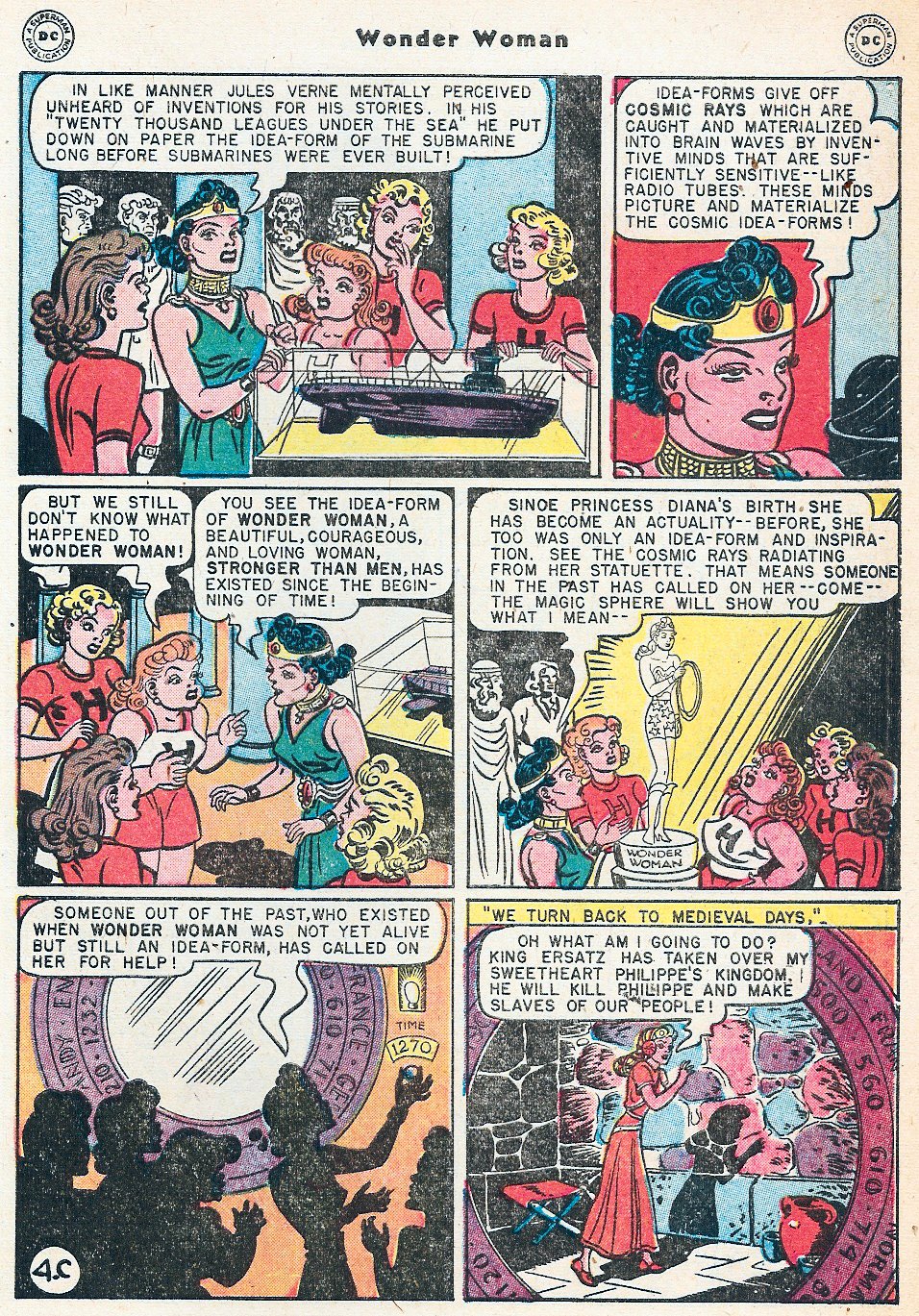In theory, this is the penultimate issue of Wonder Woman written by William Marston. in fact, as I’ve mentioned several times already, it seems very possible that many of the stories were being ghosted by this point. As with the last few issues, this is simply not that great.
So rather than belaboring that fact, I thought I’d mention a couple of things here that interested me in light of my recent post about comics and postmodernism. As I noted in that post, comics is built around reproduction of imagery and the reinscription of inaccessible deep time (memory, history, past) as a manipulable surface. I think you could argue that that is the case even in comics like this one from the 40s, suggesting a kind of precocious postmodernism.
As an example, in the first story in this comic, Diana Prince has been asked to present a medal to Wonder Woman. So WW has to figure out a way for her and Diana, her alter ego, to appear together in the same place. The solution is a technological process involving the extraction of Amazonian clay from a volcano, followed by the molding of a Diana robot/dummy, and the copious deployment of technological gadgetry. In other words, the Amazons use labor, craft, genius, and ingenuity to create a complete, coherent masterpiece — which seems like an essentially modernist solution. The Diana Prince dummy is the pulp narrative equivalent of Van Gogh’s boots).
The nature of the comic, however, pushes against a modernist achievement. The Diana doll not only replicates the real Diana Prince; it replicates itself. The doll is an image, of course, but the image of that image is repeated panel after panel. In the upper right hand panel above, Wonder Woman makes the doll speak “Hola! I’m very happy to be alive!” The doll isn’t alive, it’s only an image of life — but, of course, Wonder Woman isn’t alive either; the speech bubble coming out of her mouth is just as ventriloquized (by Marston, or whoever is speaking as Marston) as the speech bubble coming out of “Diana’s.” The final panel, as Wonder Woman hugs her doppelganger, may in part be the euphoria of a work completed. But it also seems to be the libidinal excitement of the mirror stage, when the child sees and (mentally) embraces its own (false) image. Hippolyta, WW’s mother, of course, looks on proudly as her daughter coos at her own reflection. The celebration is of the self magically and infinitely reproduced, the image reified as product and sent forth into the world to multiply, flowing within and across borders in a delirium of multiplying jouissance.
The third story in the volume has an even odder take on creativity and replication. Wonder Woman is flying the Holiday girls to Paradise Island when she is suddenly sucked out of her invisible plane. The girls land the plane, but are understandably concerned. Hippolyta, however, tells them she knows all about WW’s disappearance:
I think Marston must have written this — who else is going to spend panel after panel explicating garbled Platonism? And on he goes:
So, according to Marston, idea-forms send out cosmic rays to sensitive minds, reproducing themselves on the brain like film on a screen (Peter’s silhouettes in the bottom right as Hippolyta and the Holiday girls turn to look at the mirror/screen seems suggestive here.)
Plato said we could only see the flickering shadows of reality on the cave wall; Marston has reality beamed into our heads. Idea-forms aren’t the real tragically out of reach; they’re a fecund technology disseminated to all. Wonder Woman herself — a loving woman stronger than men — becomes a kind of viral idea, propagating itself across time and space. More than 70 years after Marston’s death, Alan Moore would create Promethea, an idea of a goddess which inhabits different women at different times. Moore thought Promethea was his own version of Wonder Woman. Based on this story, though it seems like Promethea wasn’t a version of Wonder Woman, but the idea-concept itself. The pomo version of Wonder Woman is simply Wonder Woman.
Post-modernism, which turns everything into a fetishized surface, obviously works well with Marston’s own proclivity to fetishize…well, everything. But I also wonder if his early-adoption of post-modernism might have something to do with his queerness — and perhaps his femininity. Certainly, the criticism of post-modernism as surface without depth, as merely decorative, echoes criticisms of female aesthetic endeavors, and indeed of women themselves. When you look at Harry Peter’s art (as in the image from Wonder Woman #13 below), you see pages stuffed with repetitive images of women holding, clasping, and touching each other, a consumable cornucopia of iterated catharsis.
If that also describes our post-modern landscape of bricolage, mash-up and meme, perhaps Luce Irigary should have substituted “postmodernism” for “woman”, and written:
So postmodernism does not have a sex organ? She has at least two of them, but they are not identifiable as ones. Indeed, she has many more. Her sexuality, always at least double, goes even further: it is plural….postmodernism has sex organs more or less everywhere.







Is the clay in the first story the same clay from which Hippolyta had sculpted Wonder Woman herself? I think the tangled ideas of image and reality are one step more complicated, almost fractal in the repetition.
Holy crap, good call. They never say it was, and I don’t know that it’s precisely intended on Marston’s part, but that’s an awesome link to make. Wish I’d thought of it, damn it….
I wholeheartedly approve of the postmodernism/modernism being projected (as it were) on the female/male divide. The magical visual source contrasted with the endless (nonsensical) data stream maps quite well on to the castrated and the fetishized, respectively.
————————
tony says:
Is the clay in the first story the same clay from which Hippolyta had sculpted Wonder Woman herself? I think the tangled ideas of image and reality are one step more complicated, almost fractal in the repetition.
————————
Yeah, I’d wondered about that clay too…
http://benshelor.files.wordpress.com/2008/10/693px-drawinghands2.jpg
Hey– I ripped off your Luce Irigaray quote for an article I’m writing about Claude Cahum, where I disagree slightly with her appropriation as postmodern (both of them, actually)–
In her poetic and polyvocal memoir Disavowals, pioneering performance artist Claude Cahun characterizes herself thusly: “Indiscreet and brutal, I enjoy looking at what’s underneath the crossed-out bits of my soul. Ill-advised intentions have been revised there, become dormant; others have materialized in their place.” Put into the context of her identity-queering photographic portraits and social interventions, her words suggest some of what would come to set feminist and queer performance apart from both modernism’s heroic quest for objective essence and postmodernity’s freeform indulgence– a meandering but obsessive attempt to confront oneself primarily through deeds, and only secondarily via images and ideas.
The Art Institute is hosting a landmark show of Cahun’s photographs, shockingly the first touring solo exhibit of her work in the U.S. Not only adopting a variety of female and male identities in her photos, but frequently doubling her face with mirrors, masks, and montage, she was in the 1920s about half a century ahead of fellow French feminist Luce Irigaray, who said of woman: “Her sexuality, always at least double, goes even further: it is plural….the woman has sex organs more or less everywhere.”
“Claude Cahun”, sorry, if you were trying to look her up– cat was meowing…..